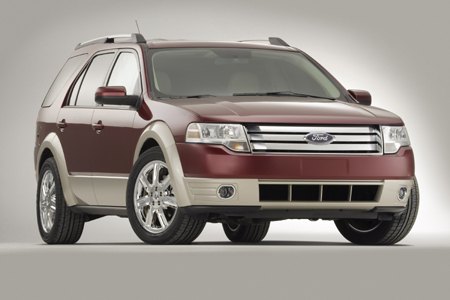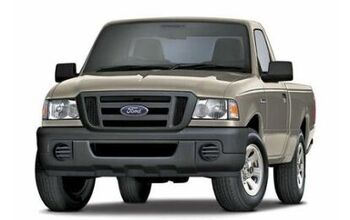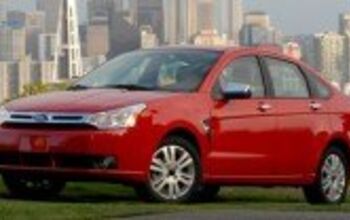Review: 2008 Ford Taurus X
Ford likes SUVs so much that they build five platforms for ‘em, many of which fight amongst themselves for sales in overlapping segments. Yet the most competitive, the most relevant of Ford’s sport-utilities is also the one no one— not even Ford marketing— seems to know exists: the Taurus X, née Freestyle. Question: if a terrific CUV falls in the sales charts and nobody in Dearborn notices, does it exist?
In 2005, while Ford’s PR team was busy blowing smoke about “Bold Moves,” the Freestyle slipped quietly into dealerships with a C.V. as impressive as a certain ex-Boeing exec’s. Sub-Highlander height? Check. Super-Highlander interior space? Check. Agile, rock-solid chassis derived from the previous-gen Volvo S80’s? Ja, that too.
So what’s caused this clever crossover to languish on dealer lots? Two little words: no marketing. Two years after its “soft launch,” the Freestyle was abandoned for the Next Big Thing (a.k.a. the Edge). As the Freestyle had less name recognition than the Explorer (or, for that matter, the Donkervoort S8AT), CEO Alan Mulally felt free to rename the model a Taurus X. By then the Freestyle was so far under the radar Ford could have called it the F-Up and no one would have noticed.
And yet, as TTAC proclaimed last time ’round, Ford’s crossover is well worth a second look. Despite a hasty application of Ford’s new Norelco nose, the Taurus X wears tidy, tallish proportions topped with a tastefully anonymous greenhouse. Call it a hemmed-out Outback, or a slim-fit Explorer. You could also call it anodyne. Narcoleptic or not, the Taurus X avoids the bulbous look blighting many vehicles in its class.
The X’s cabin exhibits similar restraint. It’s an easy step into the wide, elevated driver’s seat. The raised helmspot combines with thin pillars and a generous glass area to provide a widescreen windscreen. The no-nonsense dash is clean and conservatively curved, comprised of barely-pliable plastics and parts-bin switchgear. A thick, rubberized grab bar perches atop the glovebox, perfect for panicky co-pilots who brace themselves for every lane change (you know who you are).
Prefer to banish those passengers to the back? They won’t need much convincing. The Taurus X’s low, flat floor and tall ceiling provide van-like space in the second row, with two properly propped-up “captain’s chairs” ready to quell complaints on long trips. A cavernous console bin with two deep cupholders separates these comfy thrones; a conventional three-across bench seat is a no-cost option.
Then there’s Taurus X’s piece de resistance: the third-row seat. Okay, this isn’t the sort of thing that gets pistonheads’ blood pumping. But the X’s “way-back” is a packaging marvel that offers a wide, easy step-through to a mini-bench sized for real, live humans. Even teenagers (who share over 99 percent of their DNA with humans) will find knee clearance uncontestable, with surplus space overhead for carefully-groomed manes and coifs.
It’s difficult to overstate the importance of a decent third row, as anyone who’s done much crossover cross-shopping can attest. In this class, only GM’s Lambda triplets offer such magnanimous space for seven, and the Enclave, Acadia and Outlook are nearly one thousand pounds porkier– each– than the Taurus X. The Toyota Highlander’s third row, by comparison, is a nicely-trimmed tuna can.
The Ford and Toyota go tit for tat when it comes to hauling familial detritus. Each offers huge floor space in back; the Toyota offers a bit more of it, while the Ford boasts a lower liftover. The Highlander shames the X’s weak 2,000 lbs, tow rating; the Ford busts a can of fold-ass on the front passenger’s seat.
Here’s another X feature that’s missing from the Toyota: steering feel! Now, don’t get too excited here. While offering more feedback than most of its rivals, the Taurus X’s power assisted helm still feels gummy and a touch light around the straight-ahead. But it carves linear, reassuring arcs in curves. And that means the X drives smoothly, easily, and, well, no differently than the four-door Taurus. It ought to, considering that the X sits only six inches taller than its sedan stablemate, with the same driver eyepoint.
Performance? Yes, there’s some of that, too, as the Freestyle’s badge and grille weren’t the only things Ford swapped out for 2008. There’s also a new 3.5-liter V6, weighing in at 263 horsepower, mated to a six-speed automatic. This combination provides a steady, seamless supply of oomph; albeit delivered in that distant, detached manner endemic to quiet, high-riding vehicles. The auto occasionally dithers when asked to downshift, magnifying the impression. But then, no three-row crossover is a street scorcher.
Even as Ford’s SUV stable swells to bursting, the mpg Taurus X is the best of the bunch: reasonably frugal, perfectly practical, wonderfully comfortable and thoroughly modern. But Ford’s stunning lack of situational and self-awareness condemns the Taurus X to obscurity. Thus the mighty have fallen.
More by P.J. McCombs
Latest Car Reviews
Read moreLatest Product Reviews
Read moreRecent Comments
- Jalop1991 In a manner similar to PHEV being the correct answer, I declare RPVs to be the correct answer here.We're doing it with certain aircraft; why not with cars on the ground, using hardware and tools like Telsa's "FSD" or GM's "SuperCruise" as the base?Take the local Uber driver out of the car, and put him in a professional centralized environment from where he drives me around. The system and the individual car can have awareness as well as gates, but he's responsible for the driving.Put the tech into my car, and let me buy it as needed. I need someone else to drive me home; hit the button and voila, I've hired a driver for the moment. I don't want to drive 11 hours to my vacation spot; hire the remote pilot for that. When I get there, I have my car and he's still at his normal location, piloting cars for other people.The system would allow for driver rest period, like what's required for truckers, so I might end up with multiple people driving me to the coast. I don't care. And they don't have to be physically with me, therefore they can be way cheaper.Charge taxi-type per-mile rates. For long drives, offer per-trip rates. Offer subscriptions, including miles/hours. Whatever.(And for grins, dress the remote pilots all as Johnnie.)Start this out with big rigs. Take the trucker away from the long haul driving, and let him be there for emergencies and the short haul parts of the trip.And in a manner similar to PHEVs being discredited, I fully expect to be razzed for this brilliant idea (not unlike how Alan Kay wasn't recognized until many many years later for his Dynabook vision).
- B-BodyBuick84 Not afraid of AV's as I highly doubt they will ever be %100 viable for our roads. Stop-and-go downtown city or rush hour highway traffic? I can see that, but otherwise there's simply too many variables. Bad weather conditions, faded road lines or markings, reflective surfaces with glare, etc. There's also the issue of cultural norms. About a decade ago there was actually an online test called 'The Morality Machine' one could do online where you were in control of an AV and choose what action to take when a crash was inevitable. I think something like 2.5 million people across the world participated? For example, do you hit and most likely kill the elderly couple strolling across the crosswalk or crash the vehicle into a cement barrier and almost certainly cause the death of the vehicle occupants? What if it's a parent and child? In N. America 98% of people choose to hit the elderly couple and save themselves while in Asia, the exact opposite happened where 98% choose to hit the parent and child. Why? Cultural differences. Asia puts a lot of emphasis on respecting their elderly while N. America has a culture of 'save/ protect the children'. Are these AV's going to respect that culture? Is a VW Jetta or Buick Envision AV going to have different programming depending on whether it's sold in Canada or Taiwan? how's that going to effect legislation and legal battles when a crash inevitibly does happen? These are the true barriers to mass AV adoption, and in the 10 years since that test came out, there has been zero answers or progress on this matter. So no, I'm not afraid of AV's simply because with the exception of a few specific situations, most avenues are going to prove to be a dead-end for automakers.
- Mike Bradley Autonomous cars were developed in Silicon Valley. For new products there, the standard business plan is to put a barely-functioning product on the market right away and wait for the early-adopter customers to find the flaws. That's exactly what's happened. Detroit's plan is pretty much the opposite, but Detroit isn't developing this product. That's why dealers, for instance, haven't been trained in the cars.
- Dartman https://apnews.com/article/artificial-intelligence-fighter-jets-air-force-6a1100c96a73ca9b7f41cbd6a2753fdaAutonomous/Ai is here now. The question is implementation and acceptance.
- FreedMike If Dodge were smart - and I don't think they are - they'd spend their money refreshing and reworking the Durango (which I think is entering model year 3,221), versus going down the same "stuff 'em full of motor and give 'em cool new paint options" path. That's the approach they used with the Charger and Challenger, and both those models are dead. The Durango is still a strong product in a strong market; why not keep it fresher?







































Comments
Join the conversation
I owned a 1999 Windstar for 8 years. It was a great vehicle but I was never a minivan person. In 2005 the Freestyle came out, I fell in love with its simple utilitarian design that didn't look like a minivan. I haven't had any issues with the CVT with almost 116000 miles. My opinion is that this is an awesome car that I am thankful was underappreciated by everyone. I purchased this one $6000 under book value.
Following three Dodge Caravans over the last 13 years, we just bought an '08 Taurus X SEL AWD for my wife. Personally, I have always hated driving a van but with two kids and a medium sized dog it is a very practical vehicle. I must say that I was very positively surprised with the driving experience and the road feel. Granted, it's no BMW and you won't take it out for pure driving enjoyment. That said, it's a very capable people hauler with tons of gizmos and a very attractive price tag.